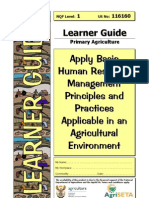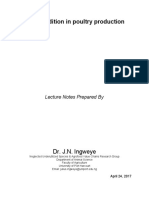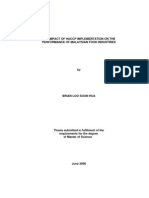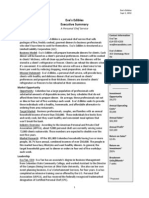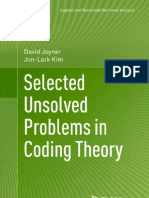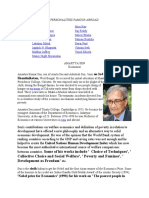Broiler Production S.B.a - Agricultural Science
Broiler Production S.B.a - Agricultural Science
Uploaded by
darrenramnarine2007Copyright:
Available Formats
Broiler Production S.B.a - Agricultural Science
Broiler Production S.B.a - Agricultural Science
Uploaded by
darrenramnarine2007Original Title
Copyright
Available Formats
Share this document
Did you find this document useful?
Is this content inappropriate?
Copyright:
Available Formats
Broiler Production S.B.a - Agricultural Science
Broiler Production S.B.a - Agricultural Science
Uploaded by
darrenramnarine2007Copyright:
Available Formats
ST.
STEPHEN’S COLLEGE
CSEC Agricultural Science (Single Award) Investigate Report
LIVESTOCK INVESTIGATIVE PROJECT
Name of Student: Darren Ramnarine
Student Registration No.:
Name of School: St. Stephens College
Title of Project: The Effect of Stocking density on Broiler Production at St. Stephens College Trinidad
& Tobago
Project Start Date: 29th December 2022
Project End Date: 2nd February 2022
TABLE OF CONTENTS
Topics Pages
Introduction 2
Methodology 3-5
Broiler Production Activities 6-9
Results 10-13
Graphs 14-15
Discussion 16-19
Conclusion 20
Recommendations 21
References 22
Cost Analysis 23-28
Broiler Production Activities – Pictures 29
Darren Ramnarine – St. Stephen’s College 1
INTRODUCTION
Background Information:
The ‘Gallus Gallus Domesticus’ or commonly referred to as ‘Broilers,’ is a type of chicken that is
reared specifically to produce meat for consumption. Due to this bird’s high feed conversion ratio, low
levels of activity and fast growth rates, the Broiler has become a popular choice of livestock amongst
farmers in the Caribbean. Some common breeds which are reared throughout the Caribbean include: the
Vantress Cross, the Peterson, and the Shaver. Typically, Broilers are reared for four to six weeks until
they obtain a weight of about two kilograms, before being slaughtered. Besides being a valuable
agricultural enterprise, which supplies farmers with substantial amounts of revenue on a commercial
scale, Broilers provide a great source of protein, and supplies the human body with nutrients such as
iodine, iron, zinc, B-12 vitamins, and essential fatty acids. In this experiment, the effects of Stocking
Density on Broiler production at St. Stephen’s College will be investigated.
Problem Statement: At St. Stephen’s College, the effects of Stocking Density on Broiler growth and
weight gain are undetermined.
Hypothesis: The Broilers present in the pen with a lower Stocking Density will have a greater weight.
Aim: To investigate the effects of Stocking Density on Broiler growth and weight gain at St. Stephen’s
College.
Darren Ramnarine – St. Stephen’s College 2
METHODOLOGY
Table 1. - Materials And Apparatus for Experiment
Materials Apparatus
Concrete Bricks 6 Waterers
5 Bags Of - Wood Shaving 2 Feeders
2 Bags Of - Starter Ration Feed Rake
2 Bags Of - Finisher Ration Feed 100-Watt Light Bulb
50 – Day Old Chicks Shovel
1 Pack of Vitalyte 60 kg Scale
Water Feed Bags
Disinfectant Buckets
Feed Scoop
Garden Hose
Broom
2 - Barrels
Chicken Wire
Sharp Knife
Outdoor Stove
Plucking Machine
Darren Ramnarine – St. Stephen’s College 3
Experimental Design: 29th December 2022 to 2nd February 2023
1) Fifty chicks were brooded for 2 weeks in one pen which provided 225 𝑐𝑚! per chick.
2) After brooding, 2 different pens of dimensions 2 𝑚 and 1 𝑚 respectively to give an area of 2 𝑚!
for each pen. One pen was labelled ‘Treated Pen’, and the other was labelled ‘Controlled Pen.’
3) Three waterers and one feeder were placed in each pen to occupy an area of 0.36 𝑚! leaving an
area of 1.64 𝑚! for the chickens.
4) Thirty birds were placed in the ‘Treated Pen’ and twenty birds were placed in the ‘Controlled
Pen.’
5) The Stocking Density for the ‘Controlled Pen’ was 12 birds per 𝑚! and the Stocking Density for
the ‘Treated Pen’ was 18 birds per 𝑚! .
Darren Ramnarine – St. Stephen’s College 4
Data Collection: Over the experimental period the following data was collected in tables and in graphs.
1) Average Weight: Upon the commencement of the experiment the chicks were weighed. The
Average Weight was calculated by weighing 3 birds from each pen, every week. The three
values were added up and then divided by three to calculate the weekly Average Weight
2) Average Feed Consumption per bird per week: The mass (g) of feed given to each pen, for every
week was recorded. The mass of the feed that remained at the end of every week for each pen
was also recorded. The Average Feed Consumption was calculated by subtracting the mass of
feed that remained weekly from the mass of the feed given to a specific pen weekly and then
dividing the result by the number of birds present in the respective pens.
3) Feed Conversion Ratio: The Feed Conversion Ratio was calculated using the following formula:
!""#$% '""( )*+,#" (.)
𝐹𝑒𝑒𝑑 𝐶𝑜𝑛𝑣𝑒𝑟𝑠𝑖𝑜𝑛 𝑅𝑎𝑡𝑖𝑜 =
!""#$% !").0+ .,)* (.)
4) Broiler Mortality: The Broiler Mortality was determined by counting the number of Broiler birds
present in each pen, each week.
Darren Ramnarine – St. Stephen’s College 5
BROILER PRODUCTION ACTIVITIES
● Slaughtering and Marketing
1. The desired bird to be slaughtered was selected.
2. The bird was placed under a bucket with its neck and head exposed.
3. The jugular vein of the bird which is in the neck was cut using a sharp knife and the bird would
be allowed to bleed for two minutes.
4. Scalding can now take place. The carcass of the bird was placed in a bucket of water at a
temperature of 60°C for one minute. Immediately after the feathers were removed in a plucking
machine.
5. The head and the neck were removed to allow the loosening up of the internal organs in the
upper cavity.
6. A cut was made all around the vent area to allow the removal of the offals. When the offals are
removed, the heart, liver, gizzard, and neck are separated and cleaned.
7. The bird carcass was then washed, and the heart, liver, gizzard, and neck were stuffed back into
the vent opening. The bird was packaged in a polythene bag and sent out to be sold or frozen.
Darren Ramnarine – St. Stephen’s College 6
● Brooder Preparation
1. The Brooder was mended and fenced to prevent the entry of predators and 225𝑐𝑚! was allowed
per chick, space wise.
2. A footbath containing disinfectant was placed at the entrance of the brooder to prevent the
transfer of diseases.
3. The Brooder was sanitised two to three days prior to the arrival of the chicks.
4. Five to Seven inches of litter was placed over the concrete floor of the brooder to absorb
droppings and keep the chicks cool.
5. Sheets of newspaper were spread over the litter for the introduction of feed from the mini
feeders.
6. Mini waterers and mini feeders were introduced into the brooder.
7. Heat was provided to the chicks by suspending a 100-watt bulb.
Darren Ramnarine – St. Stephen’s College 7
● Pen Preparation
1. Any old saw dust that was present in the pen was removed.
2. The pen was washed out using water and it was sanitised.
3. The pen was mended to prevent the entry of unwanted predators.
4. A footbath containing disinfectant was placed at the entrance of the pen to prevent the transfer of
diseases.
5. Ten to Fifteen centimetres of sanitised litter was placed on the floor to absorb droppings and
moisture.
● Nutrition
1. From week 1 to week 4, the Broiler Birds were given Starter Ration.
2. From week 5, the Broiler Birds were given a mixed ration consisting of both Starter and Finisher
ration.
3. From week 6 to the remainder of the Broiler Birds lifetime, they were given Finisher Ration.
● Litter Management
1. The Material that was used for litter was Wood Shavings.
2. The litter in the pens and brooder was broken up with a garden rake.
3. The litter was combined and mixed to incorporate any moisture and droppings and keep the litter
dry.
4. Any wet litter was removed with a shovel and replaced with fresh dry litter.
Darren Ramnarine – St. Stephen’s College 8
● Weighing
1. The Broiler bird to be weighed was identified and using both hands the Broiler bird was captured
and held firmly.
2. The Broiler bird was placed on the scale and the weight value was recorded.
Darren Ramnarine – St. Stephen’s College 9
RESULTS
Average Live Weight of Broiler birds
Table 2. -Average Live Weight of Broiler Birds in Treated and Control Pens
Time (Weeks) Average Live Weight of Broiler Birds (g)
Treated Pen Control Pen
3 625 g 850 g
4 1488 g 1725 g
5 1900 g 2066 g
6 3100 g 3600 g
Based on the results collected above, the average Live Weight of the Broiler birds in the Treated
Pen for weeks 3, 4, 5 and 6 were 625 g, 1488 g, 1900g and 3100g respectfully. In the Controlled Pen,
the average Live Weight of the Broiler Birds were 850 g, 1725 g, 2066 g, and 3600 g. The difference
between the average weight of the Treated and Controlled pens for week 3 was 225 g, in week 4 a
difference of 237 g, in week 5 a difference of 166 g and in week 6 a difference of 500 g. From the data
collected it can be determined that the Broiler birds in the Control Pen had a higher Average Live
Weight than the Treated Pen.
Darren Ramnarine – St. Stephen’s College 10
Average Feed Consumption per bird per week
Table 3. -Average Feed Consumption of Broiler in Treated and Control Pens
Time (Weeks) Average Feed Consumption per bird per week
Treated Pen Controlled Pen
3 417 g 575 g
4 1033 g 1125 g
5 1267 g 1280 g
6 1577 g 1763 g
Total Average Amount of 4294 g 4743 g
Feed Consumed
Based on the data collected, the Average Feed Consumption per bird per week for the Treated
Pen was 417 g for week 3, 1033 g for week 4, 1267 g for week 5 and 1577 g for week 6. In the
Controlled Pen, the Average Feed Consumption was 575 g for week 3, 1125 g for week 4, 1280 g for
week 5 and 1763 g for week 6. It was observed that the Controlled Pen had consumed a Total Average
Amount of Feed of 4743 grams, a 449 grams difference in feed when compared to the 4294 grams of
Total Average Feed Consumed by the Treated Pen.
Darren Ramnarine – St. Stephen’s College 11
Feed Conversion Ratio of Broiler birds.
Table 4. -Feed Conversion Ratio of Broiler Birds in Treated and Control Pens
Time (Weeks) Feed Conversion Ratio of Broiler Birds
Treated Pen Controlled Pen
3 1.85 1.28
4 1.20 1.29
5 3.08 3.75
6 1.31 1.15
Average (F.C.R.) 1.86 1.87
The Feed Conversion Ratio in the Treated Pen for weeks 3, 4, 5, and 6 were 1.85, 1.20, 3.08 and
1.31, respectively and the Average F.C.R. was calculated to be 1.86. In the Controlled Pen, for weeks 3,
4, 5, and 6 were 1.28, 1.29 3.75 and 1.15 the Average F.C.R. was found to be 1.87. It was observed that
the progress of the F.C.R.s were not constant as the values fluctuated throughout the 5th to 6th week
period. Furthermore, the F.C.R.s were generally the same as the Controlled Pen’s F.C.R. was only
higher than the Treated Pen’s F.C.R by 0.01.
Darren Ramnarine – St. Stephen’s College 12
Broiler Mortality
Table 5. -Broiler Mortality in Treated and Control Pens
Time (Weeks) Number Of Birds Surviving
Treated Pen Control Pen
3 30 20
4 30 20
5 30 20
6 28 19
The number of Broiler birds surviving in the Treated Pen for weeks 3, 4, 5, and 6 were 30, 30,
and 28 respectively. It can be observed that 2 birds died in the 6th week. The number of Broiler birds
surviving in the Controlled Pen for weeks 3, 4, 5, and 6 were 20, 20, 20 and 19. It can be observed that 1
bird died in week 6. Overall, the mortality rate in the Treated Pen is higher as 2 birds died in this pen as
compared to the Controlled pen in which one bird died.
Darren Ramnarine – St. Stephen’s College 13
GRAPHS
Figure 1. - Average Live Weight of Broiler Birds in Treated and Control Pens
Figure 2.- Average Feed Consumption of Broiler Birds in Treated and Control Pens
Darren Ramnarine – St. Stephen’s College 14
Figure 3.- Feed Conversion Ratio of Broiler Birds in Treated and Control Pens
Figure 4.- Feed Conversion Ratio of Broiler Birds in Treated and Control Pens
Darren Ramnarine – St. Stephen’s College 15
DISCUSSION
Average Live Weight of Broiler Birds:
In the 6th week of this experiment, it was observed that the Broiler birds in the Treated Pen had
an Average Live Weight of 3100 grams, while the Broiler birds in the Controlled Pen had an Average
Live Weight of 3600 grams. It can be determined that the birds in the Controlled Pen with the lower
stocking density of 12 birds per 𝑚1 had an average live weight of 500 grams, more than the Treated Pen
with the higher stocking density of 18 birds per 𝑚1 , at the end of the 6th week. This observation may be
since there is little to no competition in the Controlled Pen with the lower stocking density due to the
larger space available to each bird. This allows the birds easier access to feed which may result in an
increase in weight, as compared to the Treated Pen with a higher stocking density and a higher
competition due to the smaller space available to each bird, which may have limited the amount of feed
consumed by each bird and hence decreased their potential weight gain. Similar results were acquired in
a study done by (Puron et al.,1995) in which birds reared at a lower stocking density of 10 birds per 𝑚1
had an average live weight of 2604 grams, a 440 grams difference in average live weight compared to
the 2164 grams of average live weight by birds reared at a higher stocking density of 20 birds per 𝑚1 .
Darren Ramnarine – St. Stephen’s College 16
Average Feed Consumption per bird per week:
In this experiment over a four-week period (weeks 3 to 6), it was observed that the Broiler birds
in the Treated Pen had consumed a total of 4294 grams of feed per bird, while in the Controlled Pen the
Broiler birds had consumed a total of 4743 grams of feed per bird. It can be calculated that every bird in
the Controlled Pen consumed on average 449 grams of feed more than each bird in the Treated Pen. This
may be due to the Controlled Pen’s stocking density of 12 birds per 𝑚1 , allowing the Broiler birds
unrestrained access to the feed due to the reduced levels of competition. This contrasts when compared
to the Treated Pen with a stocking density of 18 birds per 𝑚1 and higher levels of competition, which
may have resulted in reduced accessibility of food for each Broiler bird. These results were seen in a
similar study conducted by (Liu et al., 2021) in which birds reared at a lower stocking density of 15
birds per 𝑚1 consumed 53.48 g of daily average feed per bird , a 4.61g difference in the daily average
feed consumption per bird when compared to the 48.87g of daily average feed consumed per bird at a
higher stocking density of 35 birds per 𝑚1 . These trends can be justified by a study conducted on
‘Broiler Production at Different Stocking Densities,’ by (Puron et al., 1995), in which it was determined
that “feed consumption declines as stocking density increases.”
Darren Ramnarine – St. Stephen’s College 17
Feed Conversion Ratio of Broiler Birds
In this experiment over a four-week period (weeks 3 to 6), it was determined that the Broiler
birds in the Treated Pen had an Average F.C.R. of 1.86 and the Broiler birds in the Controlled Pen had
an Average F.C.R. of 1.87. Though the Average F.C.R. of the Controlled Pen is higher than the Average
F.C.R. of the Treated Pen by 0.01 it can be deduced that both Average F.C.R.s are generally the same.
This similarity may be since the same breed of Broiler birds was used in both pens of the experiment
which may have influenced the F.C.R.s of the birds in both pens throughout the weeks and eventually
the Average F.C.R. at the end of the experiment. Similar results were acquired in a study done by
(Kenan, 2008) in which Broiler birds reared at a Stocking Density of 15 𝑚1 had an average Feed
Conversion Ratio of 1.62 and Broiler birds reared at a Stocking Density of 25 𝑚1 had an identical
average Feed Conversion Ratio of 1.62. In a separate study conducted by (Puron et al., 1995), F.C.R. is
similar across all stocking densities used to rear Broilers.
Darren Ramnarine – St. Stephen’s College 18
Broiler Mortality
In the 6th week of this experiment, it was observed that a total of 28 birds survived in the Treated
Pen out of the 30 pre-existing Broiler birds, while a total of 19 birds survived in the Controlled Pen out
of the 20 pre-existing Broiler birds. It can be deduced that two birds perished in the Treated Pen and one
bird perished in the Control Pen over the same four-week period. The difference in the deaths of the
broiler birds between the Treated and Control Pens may be attributed to increased levels of heat stress in
the Treated Pen due to a higher increased stocking density. This conclusion can be supported by a study
conducted by (Brossi et al., 2018) in which it was determined ‘The severity of heat stress results in a
higher number of deaths in broiler birds. The results obtained in this experiment is harmonious with the
results obtained in a similar study by (Turkyilmaz, 2008) in which Broiler birds reared at a stocking
density of 15 birds per 𝑚1 had a mortality rate of 6%, a significant difference when compared to the 12
% mortality rate amongst the Broiler birds reared at a stocking density of 25 birds per 𝑚1 .
Darren Ramnarine – St. Stephen’s College 19
CONCLUSION
To conclude it was determined that Stocking Density influences Broiler Weight Gain at St. Stephen’s
College. This was noted as the Broiler Birds reared in the Control Pen at a lower stocking density of 12
birds per metres squared had a higher Average Feed Consumption per bird and sustained a higher
Average Live Weight that the Broiler Birds reared in Treated pen with the higher stocking density of 18
birds per metres squared. Notwithstanding, it was also observed that the Broiler Birds in the Control Pen
had a similar F.C.R and Broiler Mortality Rate as the Broiler birds in the Control Pen. Therefore, it is
that reducing stocking density in pens can increase overall broiler production.
Darren Ramnarine – St. Stephen’s College 20
RECOMMENDATIONS
It is recommended that:
1. Broiler birds should be reared at a wider range of stocking densities to accurately determine the
right stocking density to rear Broiler birds at to achieve maximum profit.
2. Use different Broiler breeds in the experiment to determine if they affect Broiler Weight Gain.
3. Increase the number of trials of the experiment to eliminate errors and obtain accurate results.
Limitations
Some limitations which affected the experiment include:
1. Broiler birds were only reared at two Stocking Densities.
2. Only one breed of Broiler bird was used in the experiment.
3. The Stocking Density values would have been affected due to birds dying in both Controlled and
Treated Pens.
Darren Ramnarine – St. Stephen’s College 21
REFERENCES
Liu, Z. L., J. J. Xue, X. F. Huang, Y. Chen, Q. G. Wang, S. Zhang, and C. Wang. 2021. “Effect of
Stocking Density on Growth Performance, Feather Quality, Serum Hormone, and Intestinal
Development of Geese from 1 to 14 Days of Age.” Poultry Science 100 (11): 101417.
https://doi.org/10.1016/j.psj.2021.101417.
Puron, Diego, Raul Santamaria, Jose C. Segura, and Jose L. Alamilla. 1995. “Broiler Performance at
Different Stocking Densities.” Journal of Applied Poultry Research 4 (1): 55–60.
https://doi.org/10.1093/japr/4.1.55.
T. Yanai, M. I. Abo-Samaha, S. E. El-Kazaz, and H. G. Tohamy. 2018. “Effect of Stocking Density on
Productive Performance, Behaviour, and Histopathology of the Lymphoid Organs in Broiler
Chickens.” European Poultry Science (EPS) 82 (October). https://doi.org/10.1399/eps.2018.247.
TÜRKYILMAZ, MEHMET. 2008. “The Effect of Stocking Density on Stress Reaction in Broiler
Chickens during Summer.” Turkish Journal of Veterinary & Animal Sciences 32 (1): 31–36.
https://journals.tubitak.gov.tr/veterinary/vol32/iss1/6/.
Darren Ramnarine – St. Stephen’s College 22
COST ANALYSIS
Projected Income and Expenditure – This section contains the Projected Income and Expenditure
Statements.
Projected Income - Projected Income can be defined as an estimate of the financial results expected
from an enterprise in the future. In the table below, the Projected Income was calculated to be $ 1551.20.
Table 6.- Projected Income of Experiment
Item Quantity Unit Cost Total Cost
20 Broiler birds weighing 54.4 kgs of live weight $ 23.00 per kg $ 1251.20
2.72 kg each
Plucking of the 20 20 Broiler birds $ 15.00 per bird $ 300.00
Broiler birds
Total Projected Income: - - $ 1551.20
Projected Expenditure - Projected Income can be defined as an estimation of the summation of the
total fixed and operating expenses for a specific enterprise. In the table below, the Project Expenditure
was calculated to be $1310.00.
Darren Ramnarine – St. Stephen’s College 23
Table 7.- Projected Expenditure of Experiment
Item Quantity Unit Cost Total Cost
Broiler chicks 20 chicks $ 8.00 per chick $ 160.00
Starter Ration 2 bags $ 275.00 per bag $ 550.00
Finisher Ration 2 bags $ 270.00 per bag $ 540.00
Vitalyte 1 pack $ 10.00 per pack $ 10.00
Wood Shavings 5 bags $ 10.00 per bag $ 50.00
Total Projected Expenditure: - - $ 1310.00
Projected Surplus / Loss
The Project Surplus / Loss was calculated using the following formula:
Projected Income – Projected Expenditure = Projected Surplus / Loss
$ 1551.20 - $ 1310.00 = $ 241.20
Projected Income > Projected Expenditure = Surplus
The Projected Surplus was calculated to be $ 241.20.
Actual Income and Expenditure – This section contains the Actual Income and Expenditure
Statements.
Actual Income – The term Actual Income refers to the revenue generated and received from the
production and marketing of an enterprise. In the table below, the Actual Income was calculated to be.
$ 1574.15.
Darren Ramnarine – St. Stephen’s College 24
Table 8.- Actual Income of Experiment
Item Quantity Unit Cost Total Cost
19 Broiler birds weighing 56.05 kgs of live weight $ 23.00 per kg $ 1289.15
2.95 kgs each
Plucking of the 19 19 Broiler birds $15 per bird $ 285.00
Broiler Birds
Total Actual Income: - - $ 1574.15
Actual Expenditure – The term Actual Expenditure refers to a real summation of the total fixed and
operating expenses for a specific enterprise. In the table below, the Actual Expenditure was calculated to
be $1310.00.
Darren Ramnarine – St. Stephen’s College 25
Table 9.- Actual Expenditure of Experiment
Item Quantity Unit Cost Total Cost
Broiler chicks 20 chicks $ 8.00 per chick $ 160.00
Starter Ration 2 bags $ 275.00 per bag $ 550.00
Finisher Ration 2 bags $ 270.00 per bag $ 540.00
Vitalyte 1 pack $ 10.00 per pack $ 10.00
Wood Shavings 5 bags $ 10.00 per bag $ 50.00
Total Actual Expenditure: - - $ 1310.00
Actual Surplus / Loss
The Actual Surplus / Loss was calculated using the following formula:
Actual Income – Actual Expenditure = Actual Surplus / Loss
$ 1574.15 - $ 1310.00 = $ 264.15
Actual Income > Actual Expenditure = Surplus
The actual Surplus was calculated to be $ 264. 15.
Darren Ramnarine – St. Stephen’s College 26
Comparison of the Projected and Actual Income, Expenditure and Profit
Table 10.- Comparison of Projected and Actual Income, Expenditure and Profit
Criteria Actual Calculations Projected Calculations Difference
Income $ 1574.15 $ 1551.20 $ 22.95
Expenditure $ 1310.00 $ 1310.00 $ 0.00
Profit $ 264.15 $ 241.20 $ 22.95
Income
In this experiment, the Projected Income was calculated to be $1551.20, and the Actual Income
was calculated to be $1574.15. It can be observed that the Actual Income gained deviated from the
Projected Income by a sum of + $ 22.95. This deviation or increase in Actual Income is mainly
attributed to the Broiler birds weighing more than they had been expected to at the end of the six-week
experiment. This increase in weight meant that each of the birds could be sold for more money due to
the increased units of production (Weight-kg) resulting in an increase in the Actual Income gained.
Expenditure
In this experiment, the Projected Expenditure was calculated to be $1310.00, and the Actual
Expenditure was determined to be $1310.00. It is observable that the Actual Expenditure did not deviate
or change from the Projected Expenditure initially established resulting in a difference of $00.00 when
both the Actual and Projected Incomes were compared. This balanced Expenditure results, as no further
items were purchased and used during the duration of the experiment and therefore no further cost or
expenditure was developed, resulting in the maintenance of the Actual Expenditure.
Darren Ramnarine – St. Stephen’s College 27
Profit
In this experiment, the Projected Profit was calculated to be $241.20, and the Actual Profit was
determined to be $264.15. It can be observed that the Actual Profit deviated from the Projected Profit by
a total of + $22.95. Profit is usually given in the form Income – Expenditure and as a result this course
of deviation or difference resulted as there was an increase in the Actual Income whilst the Actual
Expenditure Remained constant and equal to the Projected Expenditure. This increase in the Actual
Income proceeded as the number of units of weight produced by the broiler birds experienced an
increase. This resulted in a higher Actual Income and hence produced a higher Actual Profit after the
constant balanced Expenditure was subtracted.
Conclusion
It can be concluded that rearing Broiler birds at St. Stephen’s College, was a profitable enterprise as a
profit of $ 264.15 was obtained.
Darren Ramnarine – St. Stephen’s College 28
Broiler Production Activities – PICTURES
Litter Management Changing of the Waterers
Weighing of Broiler Bird
Darren Ramnarine – St. Stephen’s College 29
You might also like
- Glacial Map of OhioDocument2 pagesGlacial Map of OhioSalvadora10% (1)
- Authority To Sell and Formal Client RegistrationDocument2 pagesAuthority To Sell and Formal Client RegistrationEuneun Bustamante100% (1)
- Value Chain AnalysisDocument2 pagesValue Chain Analysiskomal AgrahariNo ratings yet
- Meghan Seiple: EducationDocument2 pagesMeghan Seiple: Educationapi-545026502No ratings yet
- Justifying CRM InvestmentsDocument8 pagesJustifying CRM Investmentsrohitgarg1360No ratings yet
- Granut Oil Product TionDocument18 pagesGranut Oil Product TionAsk Melody100% (2)
- Blue and Purple Casual Corporate App Development Startup Pitch Deck PresentationDocument10 pagesBlue and Purple Casual Corporate App Development Startup Pitch Deck PresentationVidushi JainNo ratings yet
- Cafe Proposal 2-2Document6 pagesCafe Proposal 2-2Alok ShenoyNo ratings yet
- Elearning Facilitating Learning Through Technology1309Document65 pagesElearning Facilitating Learning Through Technology1309dd1335No ratings yet
- Agro Processing WPS Office 1Document20 pagesAgro Processing WPS Office 1chineme franciscaNo ratings yet
- Investment ProposalDocument3 pagesInvestment ProposalJubilyn LiborNo ratings yet
- Apply Basic Human Resource Management Principles and Practices 116160 Learner GuideDocument42 pagesApply Basic Human Resource Management Principles and Practices 116160 Learner Guideinternet9427No ratings yet
- Atif Hussain ResumeDocument3 pagesAtif Hussain ResumeAtif HussainNo ratings yet
- Adding Value To Poultry ProductionDocument9 pagesAdding Value To Poultry Productionjiningweye100% (1)
- Australian Hardware - Wollongong StoreDocument42 pagesAustralian Hardware - Wollongong StoreJoyce BalagotNo ratings yet
- Business Plan For Brilliance Home Care Services LTD - 2Document28 pagesBusiness Plan For Brilliance Home Care Services LTD - 2mutumwalubasiNo ratings yet
- Suza Business Plan (Honey Popcorn)Document49 pagesSuza Business Plan (Honey Popcorn)Cartoon WalaNo ratings yet
- Adjusted Feasibility Study of Kimcs - AbujaDocument54 pagesAdjusted Feasibility Study of Kimcs - AbujaGbadamosi OlusolaNo ratings yet
- Protein SupplementDocument93 pagesProtein Supplementdesaitejas100% (1)
- Flowchart - Industrial Work PlacementDocument4 pagesFlowchart - Industrial Work PlacementmanashkumarNo ratings yet
- October Rhapsody BembaDocument10 pagesOctober Rhapsody BembaValentine MalamaNo ratings yet
- Business Proposal Beef JerkyDocument11 pagesBusiness Proposal Beef JerkyHunairArshad50% (2)
- Business PlanDocument25 pagesBusiness PlanJay PatelNo ratings yet
- Marketing PlanDocument9 pagesMarketing PlanMuhammad AfzalNo ratings yet
- Poultry - PACRA Research - Jan'21 - 1611148534Document29 pagesPoultry - PACRA Research - Jan'21 - 1611148534Bakhtawar100% (1)
- FedericaFrancolino s40057520 FoodSafety Assessment1Document9 pagesFedericaFrancolino s40057520 FoodSafety Assessment1federicaNo ratings yet
- Business Plan Eco Lips 2018Document16 pagesBusiness Plan Eco Lips 2018Joyce HernandezNo ratings yet
- Clinic PlusDocument18 pagesClinic Plussarif78633% (3)
- The Impact of Haccp Implementation On The Performance of Malaysia Food IndustriesDocument39 pagesThe Impact of Haccp Implementation On The Performance of Malaysia Food IndustriesKho Siong Thong100% (2)
- Kwihangira UmurimoDocument7 pagesKwihangira UmurimoNsengimana100% (1)
- Gym Management SystemDocument4 pagesGym Management SystemEditor IJTSRDNo ratings yet
- Marketin Plan On Health ClubDocument21 pagesMarketin Plan On Health ClubkazirazibNo ratings yet
- In Effect 1 July 2020 662 Rotaract Club Recommended Bylaws enDocument5 pagesIn Effect 1 July 2020 662 Rotaract Club Recommended Bylaws enDistrict Rotaract Representative D9220No ratings yet
- Super CleanDocument12 pagesSuper CleanIbrahim AbdullahiNo ratings yet
- BSB51915 Diploma of Leadership and Management: BSBMKG520 Plan and Manage The Flexible WorkforceDocument21 pagesBSB51915 Diploma of Leadership and Management: BSBMKG520 Plan and Manage The Flexible Workforceneha100% (3)
- DACAAR Saffron Operation ManualDocument16 pagesDACAAR Saffron Operation ManualVinay JainNo ratings yet
- Master of Business Administration University Canada WestDocument5 pagesMaster of Business Administration University Canada WestPradeep Uday K UNo ratings yet
- Cereal KillerDocument18 pagesCereal KillerJaemina ParallagNo ratings yet
- A Study On Consumer Buying Behavior Nicrome Leather Processing Industry at CoimbatoreDocument13 pagesA Study On Consumer Buying Behavior Nicrome Leather Processing Industry at CoimbatoreeshuNo ratings yet
- My ProposalDocument17 pagesMy ProposalOlayinka OlabanjiNo ratings yet
- Science 2011Document15 pagesScience 2011Chris LoNo ratings yet
- Two Brain Business Ultimate Biz Plan FInal 4Document35 pagesTwo Brain Business Ultimate Biz Plan FInal 4Adrian TorresNo ratings yet
- Helping Mothers Survive Bleeding After Birth: An Innovative Training Approach To Prevent and Manage PPH PowerpointDocument17 pagesHelping Mothers Survive Bleeding After Birth: An Innovative Training Approach To Prevent and Manage PPH PowerpointJhpiego100% (3)
- Bios Life Franchise Business Model: 2. The SolutionDocument3 pagesBios Life Franchise Business Model: 2. The SolutionLuukmuu LakkanacheewanNo ratings yet
- Pet Day Care and SalonDocument13 pagesPet Day Care and SalonAngela ThomasNo ratings yet
- BUSINESS PLAN ON Café Express & MUSIC - FinalDocument22 pagesBUSINESS PLAN ON Café Express & MUSIC - FinalJuhi Sharma100% (1)
- Global Extruded Snacks Industry 2015 Market Research ReportDocument8 pagesGlobal Extruded Snacks Industry 2015 Market Research ReportLau FreedomlightNo ratings yet
- Soldiers Field Park Master Plan Update DraftDocument16 pagesSoldiers Field Park Master Plan Update DraftrandyNo ratings yet
- Abd 702 Creating and Managing Competitive Advantage: Submitted by Student ID Submitted ToDocument21 pagesAbd 702 Creating and Managing Competitive Advantage: Submitted by Student ID Submitted ToPoonam KatariaNo ratings yet
- Fy13 Written Business Plan - Evas Edibles ExemplarDocument10 pagesFy13 Written Business Plan - Evas Edibles Exemplarapi-247379631No ratings yet
- LESOTHO Prospectus A5 Resize 1 CompressedDocument32 pagesLESOTHO Prospectus A5 Resize 1 Compressed5662q6p29mNo ratings yet
- National Health Models and The Adoption of E-HealtDocument11 pagesNational Health Models and The Adoption of E-HealtifrahNo ratings yet
- Running Head: KFC FRANCHISE 1Document4 pagesRunning Head: KFC FRANCHISE 1alex100% (1)
- Group 3 - Business Plan - FINALDocument21 pagesGroup 3 - Business Plan - FINALKrizzia Sthecy Linde AlegoriaNo ratings yet
- KFC PresentationDocument21 pagesKFC PresentationCarl VillafuerteNo ratings yet
- Gs Tea 1Document8 pagesGs Tea 1Sachin UmbarajeNo ratings yet
- Aachi Masala - Entering The North Indian Masala CategoryDocument4 pagesAachi Masala - Entering The North Indian Masala CategoryZarathos SinghNo ratings yet
- SNTIC Stadium PresentationDocument30 pagesSNTIC Stadium PresentationLas Vegas Review-JournalNo ratings yet
- CH 3 Business PlanDocument10 pagesCH 3 Business PlanWondmageneUrgessaNo ratings yet
- Organic Bites Business PlanDocument14 pagesOrganic Bites Business PlanJohn Michael EubraNo ratings yet
- Marketing Strategies For Frozen Fish Exporters in BangladeshDocument8 pagesMarketing Strategies For Frozen Fish Exporters in BangladeshDoc JoeyNo ratings yet
- Planned Inventory Change Order A Clear and Concise ReferenceFrom EverandPlanned Inventory Change Order A Clear and Concise ReferenceNo ratings yet
- Broiler Production SBADocument29 pagesBroiler Production SBATiannaNo ratings yet
- Priminer U400Document7 pagesPriminer U400Metodos E ProcessosNo ratings yet
- 1.1 Surface Anatomy and Surface Landmarks For Thoracic SurgeryDocument13 pages1.1 Surface Anatomy and Surface Landmarks For Thoracic SurgeryResidentes CirugíaNo ratings yet
- 10) Api 510 Day 2Document206 pages10) Api 510 Day 2hamedNo ratings yet
- The Fire WithinDocument66 pagesThe Fire WithinLauraHenson100% (1)
- Infectious Diseases: CowpoxDocument3 pagesInfectious Diseases: CowpoxMohammedNo ratings yet
- Chapter 1 - SEPARATIONDocument41 pagesChapter 1 - SEPARATIONhafizulhakim02No ratings yet
- Lesson 2 Diversity of PlantsDocument13 pagesLesson 2 Diversity of PlantsCynna Faye CasaoNo ratings yet
- 6A Good and Bad HabitsDocument12 pages6A Good and Bad HabitsSapphire BreezeNo ratings yet
- 0817682554Document211 pages0817682554sweet_88No ratings yet
- Methods 17Document30 pagesMethods 17kaleo4No ratings yet
- Kindun - The Desert KingdomDocument38 pagesKindun - The Desert Kingdomdizman021No ratings yet
- ORGANIC ChemistryDocument17 pagesORGANIC ChemistrySadaf SubhaniNo ratings yet
- PWMDocument7 pagesPWMsiddhartha_anirban100% (1)
- Thesis Activity UpdatedDocument1 pageThesis Activity UpdatedDainty Loren BarramedaNo ratings yet
- Receptionist Resume ExamplesDocument6 pagesReceptionist Resume Exampleszajgrwwhf100% (1)
- Indian PersonalitiesDocument16 pagesIndian Personalitiessarin15juneNo ratings yet
- MathPracticeTestsfortheACT - 2024 - SAMPLEDocument32 pagesMathPracticeTestsfortheACT - 2024 - SAMPLEVibrant PublishersNo ratings yet
- BT K4411CM2Document2 pagesBT K4411CM2thangtranNo ratings yet
- Bow Mapeh JhsDocument19 pagesBow Mapeh JhsArnel B. PrestoNo ratings yet
- Lesson Plan Unit 5F - FRIENDS GLOBAL - GRADE 11Document11 pagesLesson Plan Unit 5F - FRIENDS GLOBAL - GRADE 11LinhLyNo ratings yet
- Chem Taster Sheet 2Document1 pageChem Taster Sheet 2Haikalsalihin100coolNo ratings yet
- Wa0003.Document11 pagesWa0003.Sandeep ChitteNo ratings yet
- Prequalification List of Suppliers & Contractors FY 2022-2023 - 2023-2024Document14 pagesPrequalification List of Suppliers & Contractors FY 2022-2023 - 2023-2024gerald waihuiniNo ratings yet
- How To Bypass Facebook Phone Number Verification Using 2 Easy WaysDocument5 pagesHow To Bypass Facebook Phone Number Verification Using 2 Easy Waysjulio raimeNo ratings yet
- Kubernates-Part1Document28 pagesKubernates-Part1Sreenivas KalahastiNo ratings yet
- Development of Bakery and Confectionery Products Using Ghee Residue October PDFDocument107 pagesDevelopment of Bakery and Confectionery Products Using Ghee Residue October PDFS.K. Akhtarzai0% (1)
- Design of Concrete Bridges: Praveen NagarajanDocument18 pagesDesign of Concrete Bridges: Praveen NagarajanSSNo ratings yet











